MHR
MANUFACTURED HOUSING REVIEW
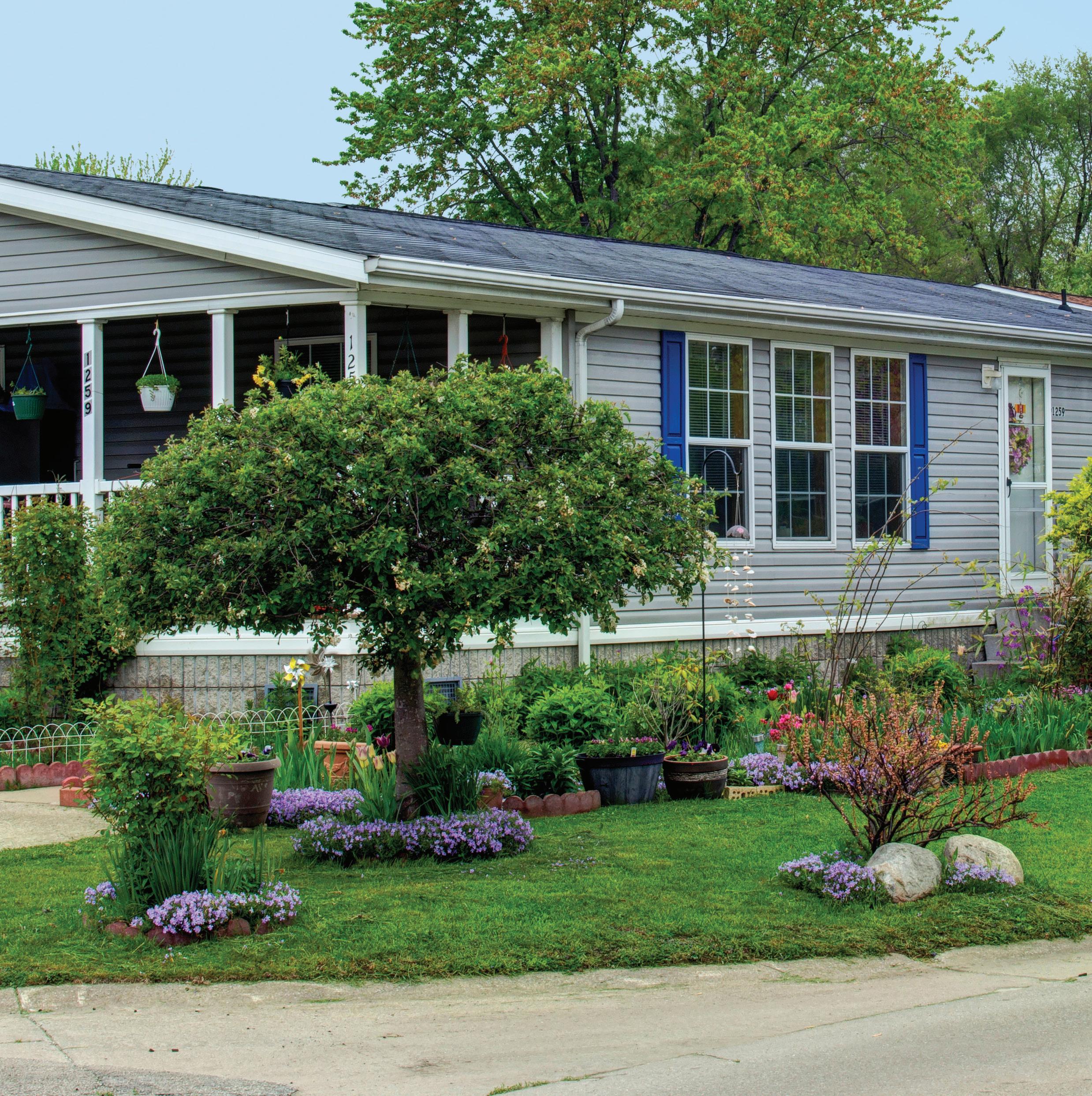
News and educational articles to help you run your business in the manufactured home industry.
IN THIS ISSUE:
Why Manufactured Homes Often Cost More To Insure Than Site Built Homes Taking The Time Magazine Article To The Next Level
What I Learned From Living In A Manufactured Home Community
We Know That Brokers Just Don’t Get It! ... and much more!
JUNE 2017
By Kurt D. Kelley, J.D.
By Stephanie McAnuff
By Spencer Roane
By Kurt D. Kelley, J.D.
By Iris Gonzalez
By DJ Pendleton
By Benjamin Ivry
Table of Contents - JUNE 2017 ISSUE 3 Publisher’s Letter
4 MHI Announces Largest 50 Manufactured Home Community Operators 5 We Know That Brokers Just Don’t Get It!
Manufactured Home in Land Lease Community vs. Site-Built 7 Home on Deeded Realty
12 Why Manufactured Homes Often Cost More To Insure Than Site Built Homes
13 Leveraging Tech, Mobile Housing Startup Aims to Disrupt Market
14 Martial Arts, Silky-Smooth Talkers, and Variable Facts:
18 Taking The Time Magazine Article To The Next Level By Frank
20 What I Learned From Living In A Manufactured Home Community By
Reynolds 21 Favorable Supply Picture Boosts Manufactured Housing REITs
Borchersen-Keto 23 Arkansas MH Association 24 Coming Soon To A Mobile Home Park Near You
Rolfe
Dave
By Sarah
Kurt D. Kelley, J.D. Publisher
Those that went through the manufactured home industry crash of 2000 know that shrinking sales and opportunities are painful. Following the manufactured housing industry’s own personal financial crash, managing a business was tough. Suppliers had to be cut-off, people you liked had to be laid off, and those you could keep had to swallow wage reductions. I was assisting with the management of the Texas Manufactured Housing Association from 2000 to 2002 and we had our budget reduced from approximately $4,000,000 per year to about $1,000,000 per year. It was simply no fun for anyone. Growing is much more fun.
Fortunately today, we are enjoying a healthy and growing manufactured housing industry. New home shipments are up in most markets. Factories typically have a six to eight week back-order. New manufactured home retailers are opening in locations that haven’t been used in 17 years. Suppliers are adding customers and volume. Finance companies are willing
and able to finance business ventures and home owners. Manufactured housing industry events are well attended. Community owners are buying new homes to fill their parks and pleased with their rising asset valuations.

You should always be planning and preparing for tomorrow, but take time occasionally to enjoy the sweet smell of a growing and healthy manufactured housing industry. The articles from our industry authors which follow are certain to help you improve your business and our industry.
Enjoy the Season!
Kurt D. Kelley, J.D. Publisher

JUNE 2017 ISSUE • 281.460.8384 • ManufacturedHousingReview.com - 3 -
Publisher’s Letter
MHI Announces Largest 50 Manufactured Home Community Owner/Operators

(LAS VEGAS, May 2, 2017)
The Manufactured Housing Institute’s (MHI) National Communities Council (NCC) released its list of the 50 largest manufactured home community owners and operators in the United States. Sun Communities of Southfield, Mich., took the top spot with 80,166 home sites under management, followed by Equity LifeStyle Properties of Chicago with 72,600 home sites, RHP Properties of Detroit with 58,264 sites, YES! Communities of Denver with 44,680 sites and Brookfield Asset Management of Toronto with 33,101 sites.
In its third year, this list is released as a highlight of the NCC Spring Forum, an educational seminar focusing on manufactured home community owners and operators. This event is in conjunction with MHI’s annual Congress and Expo for Manufactured and Modular Housing in Las Vegas.
These 50 organizations have a total of 713,169 home sites with portfolios ranging in size from more than 80,000 sites to just under 4,000.
“While the large operators continue to grow, we are also seeing growth through acquisition across all sizes of portfolios,” said Jenny Hodge, VP of Research and Market Analysis for MHI.
“These owners take pride in their professionally-managed communities. Some communities have resort-style amenities and others are more standard with a community center and playground.”
Other interesting facts are that 29 of the 50 companies are MHI members, 14 are headquartered in Calif., eight are in the greater metro Detroit area, seven are in lll., four are in Colo., two are in Fla., and most of the owner/operators have communities in more than one state.
The list was compiled using propriety MHI member information, data provided by companies on the list, as well as readily available public data. This list may be adjusted during the year.
Manufactured Home Community Facts:
• There are about 38,000 manufactured home communities in the U.S. and about 4.2 million homes sites in these communities across the country.
• Manufactured home communities are often called landlease communities.
• Benefits of living in a community includes:
o parking the car by your home
o a yard and outdoor space
o no shared walls, ceilings or floors
o in many communities, there are social or activityclubs, fitness amenities, and a sense of community among residents.
View the Largest 50 Community Owners and Operators lists for 2017, 2016 and 2015.
MHI is the only national trade organization representing all segments of the factory-built housing industry. MHI members include home builders, lenders, home retailers, community owners and managers, suppliers and more than 50-affiliated state organizations. Visit us on Twitter @MHIUpdate and on Facebook.
JUNE 2017 ISSUE • 281.460.8384 • ManufacturedHousingReview.com - 4 -
We Know That Brokers Just Don’t Get It!
Stephanie McAnuff Associate, Marcus and Millichap’s Charlotte, NC
Originally Published January 2017 in the McAnuff MHP Weekly
Controversial waters ahead! We are going to admit something you won’t hear from any other broker, ever. Brace yourselves: every property is the same for a broker. This may not come as a surprise to you as an owner of a mobile home park looking to buy or sell, but it should come a surprise to you that a broker is willing to (1) acknowledge this (many do not realize their POV differs from yours) or, gasp, (2) admit this truth. But, it’s true. Every property is the same for a broker.
Let’s clarify. In other words, an agent (broker) point of view is different from an investor/owner point of view, which is why we, and you, hear things like:

“Brokers get in the way” “Brokers just don’t get it!”
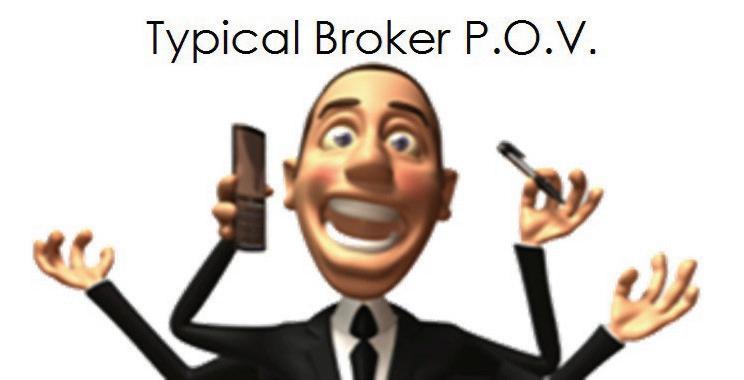

“Brokers have an agenda, and it’s not mine.” “The buyer is trying to rob me blind!”
“The buyer has money troubles.”
“The seller doesn’t understand this is a business.”
But perhaps the biggest bone of contention is with regard to the broker’s valuation of your property. You want it this price, the broker promises that price, but all the potential buyers want it so much lower. Why such a discrepancy? Well, because the truth is that most brokers just don’t get it. At McAnuff Group we understand this problem, and we are happy to admit this as brokers because we have listened to you and we have solved it. Before we look at our solution, which has been proven and even with the affirmation of “you nailed it” by a professor of real estate finance at a highly esteemed university who tested our proprietary valuation, let’s compare the two different points of view that continue to create conflict between brokers and investors based upon our deep desire to understand our clients and provide to them the best service possible:
• List the property for the highest price possible just to get the listing and deal with reality later when offers are not supporting the price.
• When the seller gets lower offers they may think that the buyer is trying to “rob them blind” or “is having money trouble.”
• Brokers cap all the income instead of understanding which income should be capped to give the most accurate valuation.
• Must look at the price in comparison to the loan.
• Determine how long the property should be held and what the exit strategy will be.
• Look at the growth potential of the property.
• Evaluate what improvements on the infrastructure can be made to recoup the cost.
• When the buyer makes an offer that makes sense based on these factors and finds an angry seller in return, the buyer thinks sellers simply “don’t understand we are trying to run a business.
JUNE 2017 ISSUE • 281.460.8384 • ManufacturedHousingReview.com - 5 -
We Know That Brokers Just Don’t Get It! cont.
Clearly there are some differences in what is important regarding if a property will sell and why an offer/sale price may be lower than a list price. When an offer is lower than what a seller wants the first problem is that the broker did not give the seller realistic expectations based upon a balanced evaluation, as is to be expected based on the broker’s point of view. Riding high on the wave of a massive listing price, a seller may feel the buyer is trying to “rob them blind” or “has money problems” when 99% of the time that simply is not the case. What we are trying to accomplish with The McAnuff Model of Property Valuation, a proprietary financial model not available anywhere else, is striking a balance between buyer and seller without unrealistic expectations, taking multiple factors into account, and resulting in more satisfying and smoother closings. Let’s look at an example of what a true offer may look like from the buyer’s point of view on a $1 million mobile home park listing: The MHP is listed for $1M, and a strong and qualified buyer offers $900K. The seller is not happy about this offer as they feel the park should go for $1 million, and was promised this by the broker. The buyer may believe the property is worth $1 million but their offer could be due to the financing behind it. Maybe traditional financing was difficult to secure because the property has “hair on it” such as too many park owned homes, well-water, bad roads, etc. Or, maybe the interest rate is high because it is seen as a riskier asset by the lender. Let’s say the buyer has an 8.5% interest rate with a 3

or 5-year balloon and a 20-year AMP. The payment for them to own this park is going to be higher per month. During the buyer’s financial analysis, they calculate that the income from the park will make the loan payment but not much will be left over, and if their goal is to get $X per year the only thing they can do is to offer a lower price, because this is a business for them and their business must be profitable. In an instance such as this, it is not the buyer being unqualified, it’s the property. One of the main problems we see in parks that have been owned for many years by the original owner is that books and records are often incomplete, and without complete books and records it’s sometimes nearly impossible for any buyer to get financing for the property.
Stephanie McAnuff is an Associate with Marcus and Millichap’s Charlotte, North Carolina office specializing in Manufactured Housing Communities. Her primary focus is the Southeast, with a secondary focus on the national marketplace. Stephanie has a working knowledge of the unique requirements of the sale and marketing of Manufactured Home Communities. In addition, her broad array of industry contacts enable her to be considered a one-stop shop, when it comes to selecting contractors, used mobile homes, movers, managers, and offering helpful industry tips and tricks that give her clients an edge in today’s market.

JUNE 2017 ISSUE • 281.460.8384 • ManufacturedHousingReview.com - 6 -
Manufactured Home in Land Lease Community vs. Site-Built Home on Deeded Realty
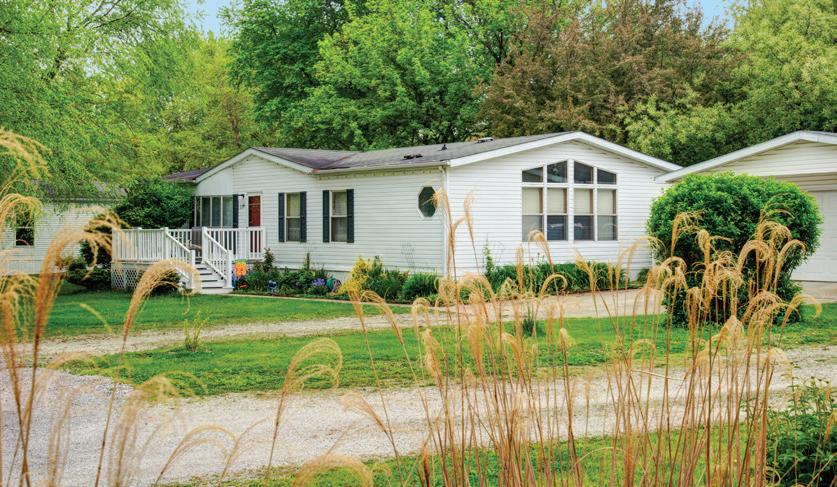
Copyright
2017; First North American Rights Only
Executive Summary
Some, especially investment and real estate “gurus”, suggest site-built homes (‘SBHs’) are better no-brainer investments than manufactured homes (‘MHs’) in land lease communities (‘LLCs’). Some claim value appreciation of SBHs versus the value depreciation of MHs is all it takes to support the SBHs-are-a-better-investment argument. In actuality, the significantly lower acquisition and ownership costs of MHs can offset the assumed value appreciation of SBHs. Also, there are some very good “beyond pure economics” factors making MHs a winner for MANY consumers.
Appreciation vs. Depreciation
True, MHs in LLCs typically depreciate in value. There are several reasons for this; the primary one being financing. There is currently no secondary market for even seasoned MH loans – as via Fannie Mae & Freddie Mac, a.k.a. Government Sponsored Enterprises (‘GSEs’). Also, provisions in mortgage reform legislation, following the 2008 meltdown - primarily the DoddFrank Act, discourage origination of mortgages for lower sales price homes. Recent “Duty to Serve” pressure on the GSEs may provide much-needed financing relief for the MH industry.
While SBHs typically appreciate in value, the housing meltdown of 2008 proved appreciation in SBH value is not a “given”. In addition, we frequently read of local areas whose home values dropped significantly due to such factors as changing demographics, plant closures, natural disasters, etc. Also, depreciation of items like automobiles and electronics obviously doesn’t discourage consumers from buying them. Finally, where’s the “property appreciation” in renting – which many consider a very viable housing alternative? So, expected value appreciation doesn’t a better investment make.
Comparing Two Similar Homes
A new SBH (home and land) costing $150,000 is somewhat comparable to a new MH costing about $50,000 sited in an LLC. Assume both are financed with 10% down payments, the SBH with a 5%/year, 30-year mortgage, and the MH with a 9%/year, 20-year mortgage. The down payment on the SBH would be $15.000 with a monthly mortgage payment of $725 versus the MH down payment of $5,000 and monthly mortgage payment of $405 (plus site/lot rent). Both homes incur realty or personal property tax (or license fee), homeowners’ insurance premiums, and maintenance costs. Assume 1% of the initial cost of the
Spencer Roane MHM, Atlanta, Ga.
homes for the annual tax, 1% for annual insurance, and 3% for annual maintenance the first year. Assume both homes are equally insulated and that utility and HVAC costs are $250/ month. Finally, assume all expenses increase 3%/year and both homes are sold at the end of 10 years, with the SBH appreciating 2%/year (gaining about 22% in value) and the MH depreciating 5%/year (losing approximately 40% of its original value).
Furthermore, assume LLC site rent is $300/mo. - so annual costs of house payment, tax, insurance, maintenance, utilities, and site rent on the MH the first-year would total $13,959. Similar costs on the SBH, without site rent, would total $19,197approximately $5,200 higher. In 10 years those costs on the MH would increase to $16,732, and on the SBH, $22,397. Using the above depreciation/appreciation assumptions, the MH would sell at the end of 10 years for about $30,000, while the SBH would sell for about $183,000. Tenth year cash flow would equal sales price, minus loan balance, minus annual ownership costs.
The total Net Present Values (‘NPV’, 3%/yr. discount rate) of all costs associated with these two alternatives over this 10-year period are about equal: $132,330 for the MH, $132,794 for the SBH.
What About Renting?
For the past several years we’ve heard and read about the popularity of “renting” instead of buying. How does this housing alternatives fare? Assume the comparable house, or apartment rents, for $1,400/mo, with the same utility costs. Given higher annual costs than even the SBH alternative, and no residual value at the end of 10 years, it’s not surprising the total NPV of the cost of the rental alternative is more than $50,000 higher than the NPV of either the MH or SBH.
JUNE 2017 ISSUE • 281.460.8384 • ManufacturedHousingReview.com - 7 -
Show Me the Data
Table 1 below shows the cash flow of these three housing alternatives over a 10-year period, based on the assumptions mentioned above.
• Higher MH depreciation. What if the MH depreciated 7%/year instead of 5%/year, resulting in loss of over 50% of its value at the end of the 10-year period? Even with that much loss in value, analysis similar to that outlined in Table 1 indicates the NPV of all housing costs would only be about $3,700 higher on the MH than on the SBH – averaging about $30 higher per month.
• Higher site rent. Site rent significantly higher than market will make MHs in LLCs much less attractive alternatives. For example, site rent of $500/month instead of $300/ month will drive the NPV of all MH housing costs over the 10-year period approximately $22,000 higher than those associated with the SBH alternative - $154,953 vs. $132,794.
What Other Factors Support MH Ownership In LLCs?
How Do the MH and SBH Compare Under Different Assumptions?
• $5,000 down payments. As mentioned above, 10% down payments require $5,000 down on the MH and $15,000 on the SBH. What if the buyer only had $5,000 for the down payment, and could qualify for financing of the SBH, with only that amount for the down payment (3.3% of the sales price)? Analysis similar to that shown in Table 1 indicates the NPV of all housing costs over the 10-year period would be about $2,000 less on the MH than on the SBH: $132,330 vs. $134,297.
• $15,000 down payments. What if the buyer had $15,000 for the down payment on either the MH or the SBH? Analysis similar to that shown in Table 1 indicates the NPV of all housing costs over the 10-year period would be about $4,800 less on the MH than on the SBH: $127,967 vs. $132,794.
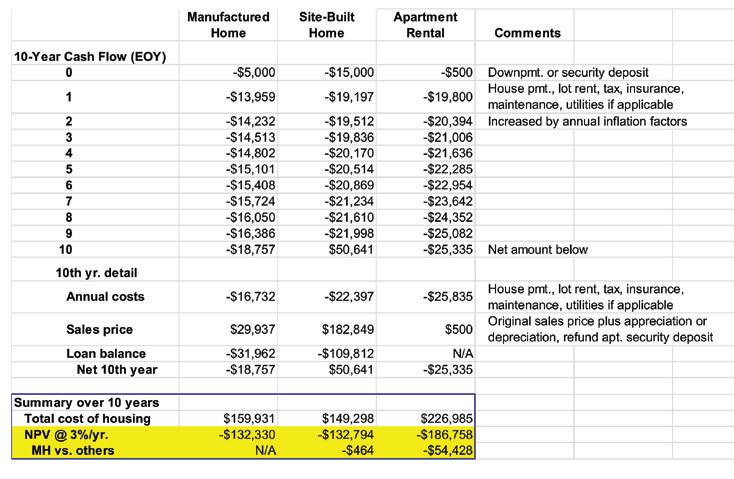
• Lower MH mortgage interest. What if interest on the MH mortgage were 7%/year instead of 9%/year – still 2%/ year higher than the mortgage on the SBH? Analysis similar to that shown in Table 1 indicates the NPV of all housing costs over the 10-year period would be about $7,400 less on the MH than on the SBH: $125,383 vs. $132,794.
• Community owner sale of MHs. Many community owners sell new MHs at little more than cost to fill vacant rental homesites, increase the cash flow and value of their communities, upgrade communities with new MHs, and attract desirable clientele. Saving $10,000 - $15,000 on the purchase of a MH could result in significantly less depreciation in value between purchase and sale.
• Affordability - Many consumers cannot afford the higher down payment ($15,000 vs. $5,000 in this analysis) and higher annual ownership costs ($5,200 in this analysis) associated with SBHs. A 30% Debt-to-Income (DTI), coupled with the Federal guideline referred to as Abilityto-Repay (ATR), means that consumers must have $17,000 higher annual income to afford $5,200 in higher annual home ownership costs.
• Conventional mortgage underwriting. Many consumers can’t satisfy other conventional financing underwriting requirements - due to credit scores, employment history, and verification of income.
• Construction quality. MHs are built in climate-controlled factories according to the strict HUD, performance-based construction code, unlike some lower end, poor quality SBHs built to lax, or often non-existent, local building codes.
• Maintain MH value. The owner of a LLC has a vested interest in maintaining its investment value. Criminal background checks of prospective residents, control over
JUNE 2017 ISSUE • 281.460.8384 • ManufacturedHousingReview.com - 8 -
Manufactured Home in Land Lease Community vs. Site-Built Home on Deeded Realty cont.
domestic problems, limiting rentals in the neighborhood, removal of junk cars and trash, and eviction of undesirable residents ensures the peace and quiet of the neighborhood and maximizes MH value in LLCs, unlike SBH neighborhoods, where no such controls exist.
• Mobility. As a last resort, MHs can be relocated from one community to another.
• Place to live, not an investment. The housing meltdown of 2008 taught us not to rely on homes as investments. The value of SBHs can be up one year and down the next, not unlike the stock market.
• “ATM effect”. Inflated values of SBHs and unscrupulous mortgage “professionals”, encourage homeowners to refinance, or take out second mortgages, to “withdraw and use equity” from SBHs. Before they know it, homeowners oft find themselves “upside down” – owing more on their homes than they are worth.
• Pay more & hope to get it back later. As mentioned above, this analysis indicates that the excess proceeds which homeowners might receive when they sell a SBH are little more than a refund of the higher payments they made during the time they were buying the home.
• Downsizing. About four million people retire annually in the U.S. Many find new, smaller MHs in LLCs a very attractive housing alternative, because of new colors & décor, energy-saving options, lower property tax, and less maintenance of home and yard.
• Renting. Renting has other negative characteristics besides significantly higher housing costs, including noisy neighbors, poor construction, and lack of private parking, personal privacy, and a dedicated, private yard.
Conclusions
MHs in LLCs fare very well in terms of total housing costs when compared to comparable SBHs, mainly because the lower costs of ownership of the MH offset the possibly higher proceeds of sale associated with the SBH. Hence, appreciation of SBHs and depreciation of MHs, if they occur, are not THE deciding factors as to which housing alternative is best. MHs have other advantages over SBHs besides lower total ownership costs. Renting is a much more expensive alternative than MH or SBH ownership, and has additional negative characteristics the other two alternatives do not.
A copy of the spreadsheet used in this analysis is posted here: https://secoconference.com/PDFs/MH-vs-siteBuilt-vsaptRent.xlsx
The author wishes to thank Karie Martin with Mobile Insurance in Woodlands, Texas, and colleagues and fellow community owners George Allen, Lynn Turley, Steve Case, Larry Mathews, and David Roden for their assistance, review, and editing of this document.
Spencer Roane, MHM, is president of Pentagon Properties, Inc., and Boyd Roane, Inc., Atlanta, Ga. His firms own and manage four manufactured/mobile home parks/ communities in Georgia and Texas, and have acquired, sold, and seller-financed over 300 new and previously-owned manufactured homes. Spencer’s 33-year career in the manufactured housing industry includes membership in the Georgia Manufactured Housing Association and a founding member of the Southeast Community Owners (SECO) annual conference. He holds a B.S. degree in Electrical Engineering, a M.S. degree in Industrial Management, and both Mortgage Loan Originator and Mortgage Broker S.A.F.E. Act licenses. His writings about sales and financing of manufactured homes in communities via Lease-Option contracts are posted at www.LeaseOptionMHSales.com. Contact him at spencer@roane.com or (678) 428-0212.

JUNE 2017 ISSUE • 281.460.8384 • ManufacturedHousingReview.com - 9 -
Manufactured Home in Land Lease Community vs. Site-Built Home on Deeded Realty cont.
At Style Crest®, we’re not just another supplier.
At Style Crest we see our customers as partners. We strive to provide support, services, and products that help grow their business, so that together we can add value throughout the manufactured housing supply chain. Call us and find out what a partnership with Style Crest can do for you and your business.

Style Crest Product Offerings
Steps
Heating and
Cooling
Skirting
Plumbing
Doors
Windows
Electrical Appliances
We are your partner.

Style Crest, Inc. | www.stylecrestinc.com | 800.945.4440
Why Manufactured Homes Often Cost More To Insure Than Site Built Homes
Many have observed that manufactured homes are more expensive to insure than site built homes of equal value. Manufactured home values are generally less than site built homes, however their insurance premiums generally don’t reflect a proportionate decrease. Here are five reasons why:
1. Roofs are a larger portion of the home value. These are the most commonly damaged part of any home and thus account for a higher percentage of claims than similarly valued parts of a home. Rain, sun, wind, and hail bombard them. In some parts of the country, you’ll rarely meet anyone who’s ever paid the full cost of a roof replacement. Their insurance company has always paid the majority of that cost. And generally speaking, a manufactured home roof value is a greater proportion of the home cost than it is for a site built home. For example, a $40,000 manufactured home roof replacement may cost $6,000, or 15% of the home’s value. A $120,000 site built home roof replacement may cost $8,000, or less than 7% of the home’s value;
2. Total losses are more prevalent. Lower home values mean lower thresholds to a declared total loss. There is less room for costly repairs when compared to site built homes. Once repair costs exceed 60% or so of a structure’s value, it’s typical for an insurance company to declare a home a total loss;
3. HUD Code Rebuilding Regulations. Government rules dictate that once a HUD label has been removed by a factory representative, government regulator, or insurance adjuster following significant damage to a manufactured home, any rebuild or repair must be overseen step by step by a HUD regulator and be performed by a properly licensed rebuilder if a new title is to be issued. This is such a costly and onerous task, it’s rarely done. Because of this, manufactured homes that could be repaired for less than they can be replaced are totaled for insurance purposes, or sold to cash buyers;
4. Less competition. There are fewer contactors willing and able to repair manufactured homes than site built homes. There are also fewer insurers
Kurt D. Kelley, J.D. Small Business Owner

of manufactured homes than site built homes. Less competition generally leads to higher costs;
5. More unibody construction. Manufactured homes are often more durable than site built homes due to their tightly defined and controlled construction codes and building procedures. But this construction process may also lead to higher repair costs and quicker total losses, such is in the case of a manufactured home with a bent frame or multiple damaged roof trusses. Technically, those issues can be repaired for less than the home’s replacement cost, but practically, such isn’t usually the case.
Manufactured homes are a good value, offer safe affordable housing, and are the best housing choice for many. However, due to the above listed reasons, manufactured home owners often pay proportionately higher insurance premiums than similarly valued site built home owners.
Kurt D. Kelley, J.D. Small Business Owner Kurt@mobileagency.com
JUNE 2017 ISSUE • 281.460.8384 • ManufacturedHousingReview.com - 12 -
Leveraging Tech, Mobile Housing Startup Aims to Disrupt Market
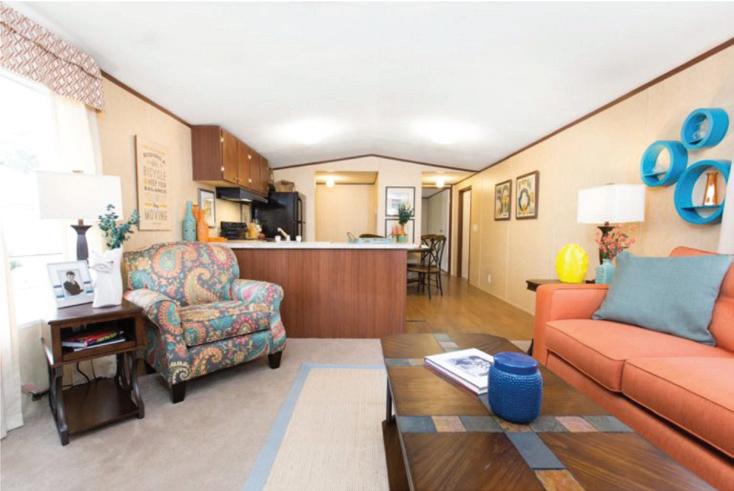
[brother Jonathan, who died after a motorcycle accident in 2015] regarding up-front pricing and an education-focused sales approach.
Four months ago we decided to venture out on our own and bring back the personal touch that only a small, family-owned and -operated business can bring. We were born and raised in San Antonio. South Texas is and always will be home. That’s why we love helping other families plant roots here.
San Antonio’s real estate market is hot – it ranks eighth on real estate website Trulia’s list of markets to watch in 2017. That demand translates into a lower inventory of affordable entry-level homes. With San Antonio’s population projected to grow by 1 million by 2040, the need for affordable housing will be even more pressing.
That’s why Alberto Piña and his brother Jason founded Braustin Mobile Homes. Informally known as the “mobile home geeks,” the Piñas launched the unconventional startup in January as a way to help entry-level buyers achieve their dream of home ownership at considerable cost savings.
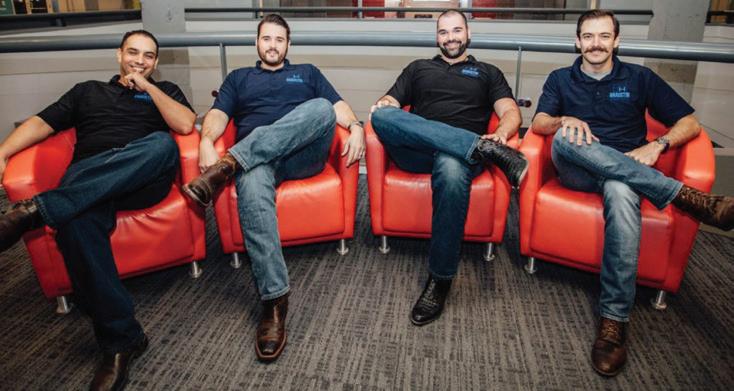
By leveraging technology, Braustin Mobile Homes has introduced what it believes is a disruptive model for selling mobile homes, creating a virtual mobile home dealership on the eighth floor of Geekdom that will be one of the featured stops on the upcoming SA Tech Trek April 25. The Rivard Report spoke to Alberto Piña about the housing startup.
Rivard Report:
What’s your experience in the housing industry?
Alberto Piña: While the name of our company may be new to the manufactured home industry, our family has over 10 years experience selling and managing teams for big mobile home companies. My brother and I decided to start our own business where we could develop an approach more in line with the modern practices of e-commerce. When Jason and I founded Braustin Mobile Homes in January of this year, we developed our concept around many of Jonny’s ideas
Read Full Article Here
Iris Gonzalez is a contributing writer covering technology, life science, and veteran affairs for the Rivard Report. A first generation Cuban American, she is also a strategic planning consultant for nonprofit and government sectors and a docent at the San Antonio Museum of Art.

JUNE 2017 ISSUE • 281.460.8384 • ManufacturedHousingReview.com - 13 -
Iris Gonzalez for the Rivard Report
COURTESY / BRAUNSTIN MOBILE HOMES.
(From left to right) Ernest Gomez, Jason Piña, Alberto Piña, and Mauricio Chacra of Braustin Mobile Homes at Geekdom.
COURTESY IMAGE
The interior of a Braustin mobile home in Poteet, Texas.
Martial Arts, Silky-Smooth Talkers, and Variable Facts:
The 2017 Texas Legislative Session
Foreword from the Publisher: Texas’ Legislature only convenes from January to May on odd numbered years. As such, if laws need to changed, there’s a limited window to do that. Below is the story of the 2017 session and the Manufactured Housing Industry’s attempts to amend laws in favor of affordable housing and property ownership rights favorable to Manufactured Home Communities. If you find politics interesting, or if you like Westerns that have a showdown at a corral with a good guy and a bad guy, it’s a great story.
Memorial Day marked the end of the 2017 Texas Legislative Session. The session that began 140 days earlier was one for the ages: conflict and compromise, hurt feelings and shared jubilation, celebratory high-fives and lots of crying into beers. This session had it all. We may be headed to overtime too, as they are likely to be called back by the Governor for a Special Session soon.
I’ll let others fill you in on the intricacies of the state budget, and the debate on property tax roll-back elections and even the contentious manner with which this session concluded; two politically opposite yet look-alike members nearing fisticuffs on the House floor with threats of shooting each other. Welcome to Texas! Instead, I’ll focus on the two bills that were the Texas Manufactured Housing Association’s (TMHA’s) top legislative priorities. These two bills directly impact both the manufactured home retail and community industries in Texas. Before I get to the trees, it is worth mentioning the forest. There were 6,631 bills filed and yes, we reviewed them all. We tracked 179 bills identified as potentially having some possible impact on the manufactured housing industry. Of all the bills filed this session, only 1,211 passed (about 18%). This year marked the second most bills filed and the fewest bills passed in the last 20 years. To translate, this was a massive bill killing session.
However, making it through the slew of dead bills and reaching the top of the battle field heap to gasp a lifesaving breath like John Snow (my token Game of Thrones reference) was one important community owners’ bill and one critical retailer bill. As of now, both are sitting on the governor’s desk awaiting, what we hope will be, his signature.
By DJ Pendleton
Next, let me tell you about Senate Bill 1248, by the brilliant, beautiful, and esteemed Sen. Buckingham. This is our Manufactured Home Community Bill that we colloquially referred to as our “right to replace Bill.” The bill does two things. If a city re-zones an area where an existing manufactured home community is located in order to restrict a manufactured home community’s ability to replace homes or retain lot sizes, the bill would deem the existing community “Grandfathered” as a “Non-Conforming Use.” This bill would protect a community owner’s right to replace homes within the community on the current lot size footprint.
This bill was an answer to cities in Texas enforcing their interpretation of “abandonment of nonconforming use” to produce a “you move it, you lose it” law. They were saying if a home leaves a community and another is not in place within their abandonment period, sometimes as short as 30-days, then the individual lot is deemed abandoned and loses its Grandfathered status. The lot is dead thereafter, never to be occupied again by a manufactured home. This results in a large financial loss for the community owner as well as a loss of affordable housing for the city.
The other tactic used by some cities is to change the setback requirements. When a home moved out and a replacement was brought in, the new home had to abide by a larger setback rule. In these instances, the setbacks were substantially increased from the original footprint resulting in much larger thruways and dramatically shrinking the total number of possible lots in a community. TMHA’s contention is such acts are veiled efforts by cities to reduce the viability of existing manufactured home communities.
S.B. 1248 makes it clear, community owners have a minimum of 12 months to replace a home and may do so on the existing lot size.
Finally, this bill adopts a statewide definition of a “Manufactured Home Community” to that of “A track or parcel of land where at least four or more sites are offered for lease for manufactured homes.” This new definition doesn’t impact existing communities. Texas has many cities adopting community definitions which trigger full manufactured home
JUNE 2017 ISSUE • 281.460.8384 • ManufacturedHousingReview.com - 14 -
Martial Arts, Silky-Smooth Talkers, and Variable Facts: cont.
community regulation locally if there is a piece of land with as few as two manufactured homes. If one had only two homes on a parcel of land then they must do things like put an eight-foot masonry wall around the property line and plant ten-foot-tall trees every 25 feet along the property line. I’m not kidding! Look up the City of Lumberton’s manufactured home community standards. Such local laws impacted family owned land where granddad owns thirty acres and allows son, daughter, and granddaughter to all live on his land in their manufactured homes. If those laws are left in place, granddad wouldn’t be able to offer this to his family. It would cost thousands of dollars for a masonry wall or an engineered water runoff analysis.
If Governor Abbott signs this bill into law, it will be effective on September 1, 2017, and Texas will join several other states (like Wisconsin and Florida) that have similar property right protection statutes.
House Bill 2019, by the brilliant, handsome, and esteemed Rep. Tracy King.
The purpose for this large bill was to address multiple areas of existing manufactured housing law and modernize the law to current practices. The bill also codifies certain aspects of regulation to ensure a more predictable regulatory future. We also sought to change the Texas manufactured home title acronym. For those unaware, the official name for a manufactured home title in Texas is “statement of ownership and location” or an “S O L” as commonly referred to with an accompanying snicker by some elitists. The term “statement of ownership and location” is used 96 times in the main chapter of the law regulating manufactured homes in Texas. Changing this was a large driver behind the bill. Despite the condescending humor exhibited by some government officials and regulators toward manufactured home owners, it remained the fact that in many cases manufactured home buyers are making the largest purchases of their lives when they buy a home. And they don’t want their title called an “S O L.”
Another important deletion in the bill is to remove all references to “lease purchase” in the current law. Similar to the gem of the “S O L,” the original 2007 Bill created the definition of a “lease purchase.” The problem is the definition is contrary to federal and other state law. It created confusion for industry and consumers. The current definition also
gave the false impression of permissible “lease purchase” contracts that if not done properly could be disguised credit transactions under other state and federal law. I want to be clear that this deletion doesn’t eliminate a person’s ability to use proper leases with options to purchase contracts. These contracts are still allowed so long as they follow state and federal laws. The deletion simply removes the confusing and contradictory term from the Texas Occupations Code.
Here are some other key industry provisions that were included in the Bill:
• Greater clarity as to when the consumer’s 3-day right of rescission begins in response to the post-Dodd/Frank reality of lending switching to a direct loan model rather than the previous retail installment contract model
• Industry protection against administrative rule increases that result in industry costs greater than $50 by triggering a cost benefit analysis to be done and presented to the MH Division’s governor appoint board prior to implementation
• Preserves that the manufactured home Retailer, Broker, Installer licensing test maintain its currently high passage rate of approximately 95 percent
• Allows for the retailer to retain a portion of a consumer’s deposit to offset the expense of appraisal or title work if the purchase includes land and the consumer rescinds the contract after those services have been paid for
• Streamlines the “warehouse” and “warehouseman” provisions so that a retailer taking a home out of community can move the home onto their lot and sell the home as they would any other home to recover their transportation and storage fees, and selling in such a manner is deemed “commercially reasonable”
• Allows a consumer to waive the 3-day right of rescission in the event of a personal disaster like a fire or flood so they can replace their home more quickly
• Clarifies the inventory versus personal property tax treatment process and changes the definition of inventory and the Tax Code to ensure that homes titled as inventory with TDHCA are only taxed as inventory and not at the higher appraised value of personal property
• Removes the requirement to prepay the current year
JUNE 2017 ISSUE • 281.460.8384 • ManufacturedHousingReview.com - 15 -
Martial Arts, Silky-Smooth Talkers, and Variable Facts: cont.
taxes on real property sales of manufactured homes that are conducted through a title company that will pro-rate the tax burden among the parties
• Eliminates the habitability inspection requirement if a home that was real property is converted back to personal property and bought by a retailer
• Allows for a home that had been previous declared abandoned, then re-abandoned again by a later buyer to be declare abandoned again by the community owner
• Ensures the department will maintain the titling, tax and licensing records on its website
House Bill 2019 includes other changes which better describe current industry and department practices as well as updates the chapter in the Texas Finance Code that regulates manufactured home personal property lending in Texas to have the correct references to the federal laws and regulations post-Dodd/Frank.
The comprehensive was signed by Gov. Abbott and will go into effect on September 1, 2017.
SUMMARY
TMHA was thrilled to achieve success on both of our ambitious legislative priorities. These changes will improve the industry, ensure a more predictable regulatory future,
benefit consumers, and protect the private property rights of community owners. Both of these efforts mark the culmination of two years’ worth of work, planning, negotiating, drafting, re-drafting, and lobbying.
We greatly appreciate all the help we had along the way from TMHA members, as well as the support of our board of directors and officers that provided us with the tools and resources to give us the best chance of success. Now, like the day after the end of a football season, we get back to recruiting, planning and preparing for the next session in 2019. We plan to grow on our success from this session and maintain our aggressive goals as we continue to advance and improve the manufactured housing industry in Texas.
DJ Pendleton has worked for the Texas Manufactured Housing Association since July 2006. First as general counsel and then in 2008 became the executive director, which is the position he holds today. Pendleton has Bachelors of Business Administration in Accounting from Texas A&M University, a Master of Science in Accounting from Texas A&M University, and a Juris Doctorate degree for Baylor University School of Law. Pendleton has been a licensed attorney in the state of Texas since May 2006.

JUNE 2017 ISSUE • 281.460.8384 • ManufacturedHousingReview.com - 16 -

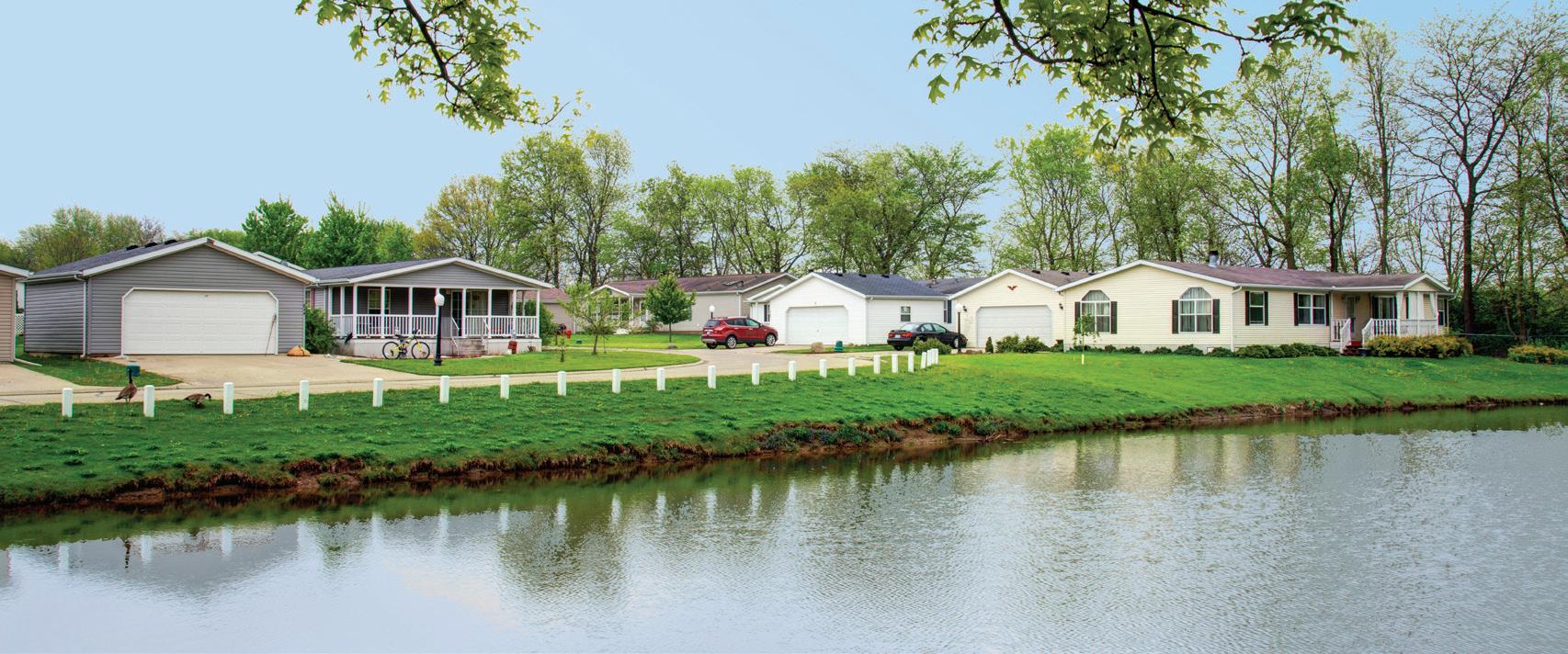
JUNE 2017 ISSUE • 281.460.8384 • ManufacturedHousingReview.com - 17 -
Taking The Time Magazine Article To The Next Level
The recent Time Magazine article titled “the Home of the Future” gave a glowing review of the manufactured home community product. The reason the writer found that “a trailer park turns out to be a superb place to grow old in” focused on the sense of community that he realized our product fosters. One classic quote from the article was “trailer parks can be thought of as gated communities for people who aren’t so wealthy”. So if a sense of community is the key to the quality of life for our residents, how can we take that to the next level?
Create an environment of support
The best way to create a sense of community in your property is to foster the positive interaction between neighbors. You can accomplish this through such initiatives as community gatherings sponsored by the management, and simply changing the atmosphere of the office to smiles and waves. Acknowledge good deeds, such as the “yard of the month”; be a good leader.
Create an atmosphere of inclusion and fairness
Residents appreciate professional management. They hate it when some owners and managers play favorites and hold some residents to a higher standard than others. If you do not treat everyone with respect, you will create a divisiveness inside the general community and there can be no cohesion. Managers should be friendly but not build alliances with certain residents at the expense of the community as a whole. The worst example of this is the community with a large Hispanic demographic but a manager that is not bilingual.
Focus on the “right” amenities
To build a sense of community, the owner should think about what amenities serve the most residents. With that in mind we recently built an upscale clubhouse in one of our communities in Austin. It is a beautiful structure and one that all residents are proud of, featuring a giant stainless-steel commercial kitchen for parties and high-end tile floors and exposed timbers. We did this because we thought that, of all the amenity options, this would be inclusive of the most residents. We have also been adding high-end playgrounds and basketball courts, as these bring residents together year round. We have not focused on swimming pools for the simple reason that they are used by only a few residents and, even then, only a few months a year. Put your money to use where it can do the most good.
Frank Rolfe
Empower your manager to do what’s right
It’s hard to build a supportive community if your manager is not leading by example. We have a manager named Angela who has devoted much personal time to helping residents improve their finances by teaching such skills as clipping coupons and also convincing non-profits to aid neighbors in need. This clearly sends a message to the greater community.
A laundry list of items to consider
Here is a laundry list of initiatives that we are currently working on.
Convincing non-profits to provide educational items and financial aid to those in need.
• Create organized activities for both youth and seniors.
• Negotiate with vendors such as Home Depot to provide needed home maintenance items at a bulk discount for residents to use to improve their property.
• Offer scholarships to those residents in need of tuition for college.
• Create transportation options for elderly residents to be able to get to doctor appointments and other destinations.
You can probably add to this list if you put your mind to it. I think we would all agree that these are worthy causes.
Some items we’ve recently accomplished – to use as a reference
In the past year, we have successfully completed many community initiatives, including:
• We gave a home away for free to a veteran in need in Mooresville, Indiana.
• We re-built a home for free for an elderly veteran in Oshkosh, Wisconsin (here’s the link to that news story http://fox11online.com/news/making-a-difference/ oshkosh-veteran-gets-home-renovation-from-helpfulneighbors )
• We donated supplies and labor to improve the property of those who could not afford to do the maintenance themselves throughout our portfolio.
JUNE 2017 ISSUE • 281.460.8384 • ManufacturedHousingReview.com - 18 -
Taking The Time Magazine Article To The Next Level cont.
• We built a library for the residents in our property in Indianapolis.
• We completed an upscale new clubhouse in our property in Austin.
• We built a new playground on our property in Cincinnati. And we have many more on the docket for the second half of 2017. These projects promote that sense of community that Time magazine raved about, and is the firm basis for a successful property.
Conclusion
The key feature to our industry – as correctly identified by Time magazine – is the sense of community. That being the
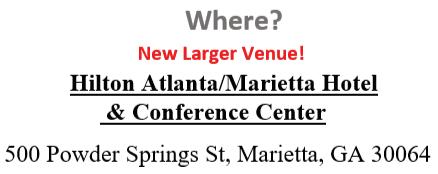

case, it benefits all manufactured home community owners to foster this attribute and make it the ultimate amenity; one that is a powerful force for properties of all shapes and sizes.

Frank Rolfe has been a manufactured home community owner for almost two decades, and currently ranks as part of the 5th largest community owner in the United States, with more than 23,000 lots in 28 states in the Great Plains and Midwest. His books and courses on community acquisitions and management are the top-selling ones in the industry. To learn more about Frank’s views on the manufactured home community industry visit www. MobileHomeUniversity.com.

JUNE 2017 ISSUE • 281.460.8384 • ManufacturedHousingReview.com - 19 -
SECO -
Community Owners successfully filling sites one new CSH Home at a time 7th Annual Community Owners Conference 350+ Small & Mid-size COs & other industry personnel from 25+ states! SECO17 Pre-SECO workshops Tuesday October 10, 2017 Wednesday and Thursday October 11 & 12, 2017 • Community Series Homes on display • 40+ Vendors and Exhibitors • Explore New Ways to Run Your Community • Fill vacant lots with new CSH homes • Acquire the Knowledge to Better Your Bottom-line
Get Tips from the Experts – Steps to Becoming More Efficient • Financing of communities and homes
Share Ideas and Best Practices to Ensure Greater Success. • Network with Fellow Community Owners and Managers. Please follow us on www.SECOconference.com Sign up for Email Updates directly on our website. 501c3 dedicated to community education
For Community Owners, By Community Owners
•
•
What I Learned From Living In A Manufactured Home Community
When I bought my first manufactured home community, Wagon Wheel of Limon, Colorado, I decided that the best way to learn the business and keep costs to a minimum doing all the work myself was to live in my property. So I moved the family in and resided there until I sold it. Years later, I moved into another property I owned, called Jackson MHP down in Texas, so I could be onsite during the turn-around phase. As a result, I can honestly say that at one time I was not only a community owner, but also a customer. So what did I learn from being a resident?
The quality of the product
The first take away for anyone who lives in a manufactured home is the quality of construction. I think a lot of the negative stereotypes about manufactured homes are written by people who have never actually set foot in one. I found the home to be spacious, solid and engaging. I cannot figure out why people think a 1,000 sq. ft. manufactured home is any different than a 1,000 sq. ft. stick-built home. Such thinking is complete ignorance. The only real difference is the price point – which is about 75% less.
The sense of community
The recent Time magazine article titled “the Home of the Future” nailed it. The big attraction to many people is the camaraderie of your neighbors. That’s why Tony Hseih – the founder of Zappos.com – traded in a penthouse apartment in Las Vegas for a manufactured home community he purchased in Las Vegas called Airstream Park. I have never experienced an environment of as many helpful people who truly look out for one another. This benefit will see a lot more attention in the future, as the Baby Boomers are retiring at the rate of 10,000 per day, and finding supportive environments for aging will be a huge issue for America going forward.
The attractiveness of privacy
Although manufactured home communities have significantly greater density than most traditional subdivisions, this does not mean that they do not have plenty of privacy. Having been in apartments, I can attest to the fact that the manufactured home community is far superior. There is no question that the absence of neighbors knocking on your walls and ceiling, and the addition of a yard, is what makes the average consumer always choose our product type.
The unique tie to nature
The manufactured home community is a relative of the RV
Dave Reynolds
park. At one time they were one in the same, and even though they are completely different products today, they share the same attribute: a sense of the outdoors. Maybe it’s the fact that you have less separation from the environment, or the fact that so many people spend their free time and entertainment time outside their homes, but living in a manufactured home community is a little like living in one those Bass Pro Shop luxury lodges. Drive through any manufactured home community at nights or weekends, and you will find most of the residents enjoying the great outdoors. And that’s a healthy activity for all age groups.
The atmosphere of fun
If you ask my son Brandon what his greatest childhood memory was, it would be living in the manufactured home community in Hondo. It was 24/7 entertainment with a huge group of children who lived on the property. Maybe it’s because the residents are so happy – or because the focus is on personal interaction and not material possessions – but the net effect is endless fun. For kids it’s like a giant amusement park, and for adults it’s all about a low stress environment and personal relationships.
Conclusion
Back in 2014, a writer for the New York Times lived in one of our properties in Illinois and wrote an article describing his experience. He loved it. Anyone who has never actually lived in a manufactured home community has no right to talk badly of it. We have a great product and a great business model, and we truly are the “homes of the future”. And that future is now. I’m not saying that because I am a manufactured home community owner. I’m saying that because I’ve been a resident, and I know the truth.
Dave Reynolds has been a manufactured home community owner for almost two decades, and currently ranks as part of the 5th largest community owner in the United States, with more than 23,000 lots in 28 states in the Great Plains and Midwest. His books and courses on community acquisitions and management are the top-selling ones in the industry. He is also the founder of the largest listing site for manufactured home communities, MobileHomeParkStore.com.
To learn more about Dave’s views on the manufactured home community industry visit www.MobileHomeUniversity.com.

JUNE 2017 ISSUE • 281.460.8384 • ManufacturedHousingReview.com - 20 -
Favorable Supply Picture Boosts Manufactured Housing REITs

Manufactured housing REITs occupy an enviable place in the real estate market today as they continue to benefit from a dearth of new supply and healthy demand for affordable housing options, analysts say.
According to Ryan Burke, an analyst at Green Street Advisors, approximately 10 new manufactured home communities have been built in the United States in the past two decades – “an eye-popping anomaly among real estate sectors.” He notes that aging baby boomers are driving demand at age-restricted communities, while all-age communities are popular with younger families looking for affordable housing options.
“Nowhere else in real estate do we see this complete lack of new supply and the favorable demand dynamics,” Burke says. “It’s a pretty good story.”
Drew Babin, an analyst with R.W. Baird, says manufactured housing REITs and existing owners of manufactured housing communities currently have a “chokehold on the market.”
The favorable supply-demand dynamics have not been lost on investors. In 2016, manufactured housing REITs posted a total return of 28.5 percent, compared with total returns of 18.2 percent for apartment REITs and 12.8 percent for singlefamily homes during the same period. The FTSE/NAREIT All REIT Index’s total return last year was 9.3 percent.
“As [manufactured housing] continues to outperform other sectors, particularly in the private market at the property level, there’s no way the outperformance will go unnoticed,” Burke says.
Among the barriers to entering the manufactured housing market are the communities’ long lease-up periods. It can
Sarah Borchersen-Keto Associate Editor at NAREIT
take more than five years to reach a stabilized occupancy level, Burke notes. “It’s tough for a developer to be able to underwrite that lease-up period,” he adds.
Acquisitions Likely to be “Episodic”
Manufactured housing REITs generally own assets on the higher end of the quality spectrum in the market. According to Green Street, manufactured housing REITs own about 1 percent of the estimated 50,000 manufactured housing communities in the U.S., but nearly 15 percent of the institutional-quality stock.
With new supply non-existent, REITs will look to enlarge their portfolios through acquisitions as well as by expanding existing sites, analysts say. In 2016, Sun Communities, Inc. (NYSE: SUI) paid $1.7 billion to acquire a portfolio of interests in more than 100 manufactured housing and recreational vehicle (RV) communities owned by Carefree Communities Inc.
While there may be a couple of high-quality manufactured housing portfolios of comparable size to Carefree still available in the market, analysts mainly expect to see smaller deals going forward on the scale of one to two assets.
“There are a few larger, institutional-quality portfolios out there, but my view is that it will be more episodic,” says Nick Joseph, an analyst at Citi Research.
Burke points out that most of the manufactured housing parks are held by smaller investors that own up to three properties. He said they hesitate to sell for several reasons: they make a good living from the properties; they would be hit with high taxes if they sold; and many sellers would be unsure how to reinvest the proceeds to achieve similar yields.
“There’s a whole lot of demand for these properties across the board from REITs and institutional investors and very few properties coming to market relative to other property types,” Burke adds.
Indeed, the appeal of the manufactured housing sector has not been lost on international investors, according to Joseph. Singapore global wealth fund GIC took a stake in an owner of U.S. manufactured housing communities in 2016.
Strong Internal Growth Profile
Analysts agree that manufactured housing REITs enjoy a sound internal growth profile that includes the ability to increase density at existing sites where they own adjacent land.
JUNE 2017 ISSUE • 281.460.8384 • ManufacturedHousingReview.com - 21 -
Favorable Supply Picture Boosts Manufactured Housing REITs cont.
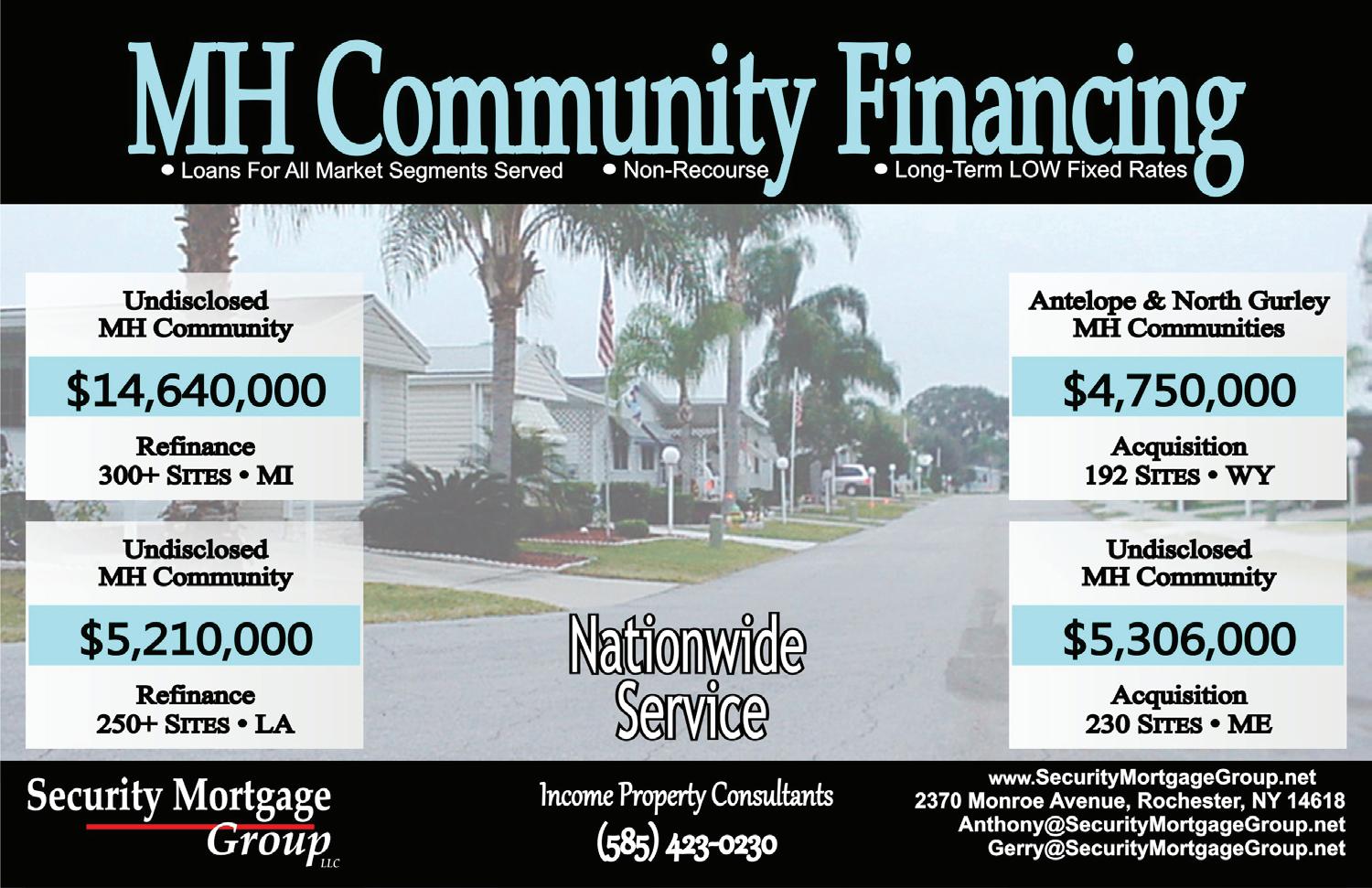
“They’ve been very aggressive about doing that because it’s so hard to find entitled land,” Babin says. “Oftentimes the best land is on their existing properties.”
At the same time, REITs will continue to push through rent increases to existing tenants. Babin notes that annual increases have been around the 3 percent range.
“It’s tough to drive rents beyond that. Tenants stay for a long time and you don’t want to get too aggressive,” he adds.
Meanwhile, REIT portfolios also include RV parks – a segment that offers the REITs more flexibility to pass on rent increases when new amenities are added, according to Babin.
RV parks comprise about 25 percent of manufactured housing REITs’ revenue, a number that has increased dramatically in the last 10 years, according to Burke. “REITs have used RV parks as another avenue of growth,” he says.
Sarah Borchersen-Keto Associate Editor at NAREIT
JUNE 2017 ISSUE • 281.460.8384 • ManufacturedHousingReview.com - 22 -
Arkansas MH Association

https://www.youtube.com/channel/UCEK7ywAb0F81K0Cll9plOAA
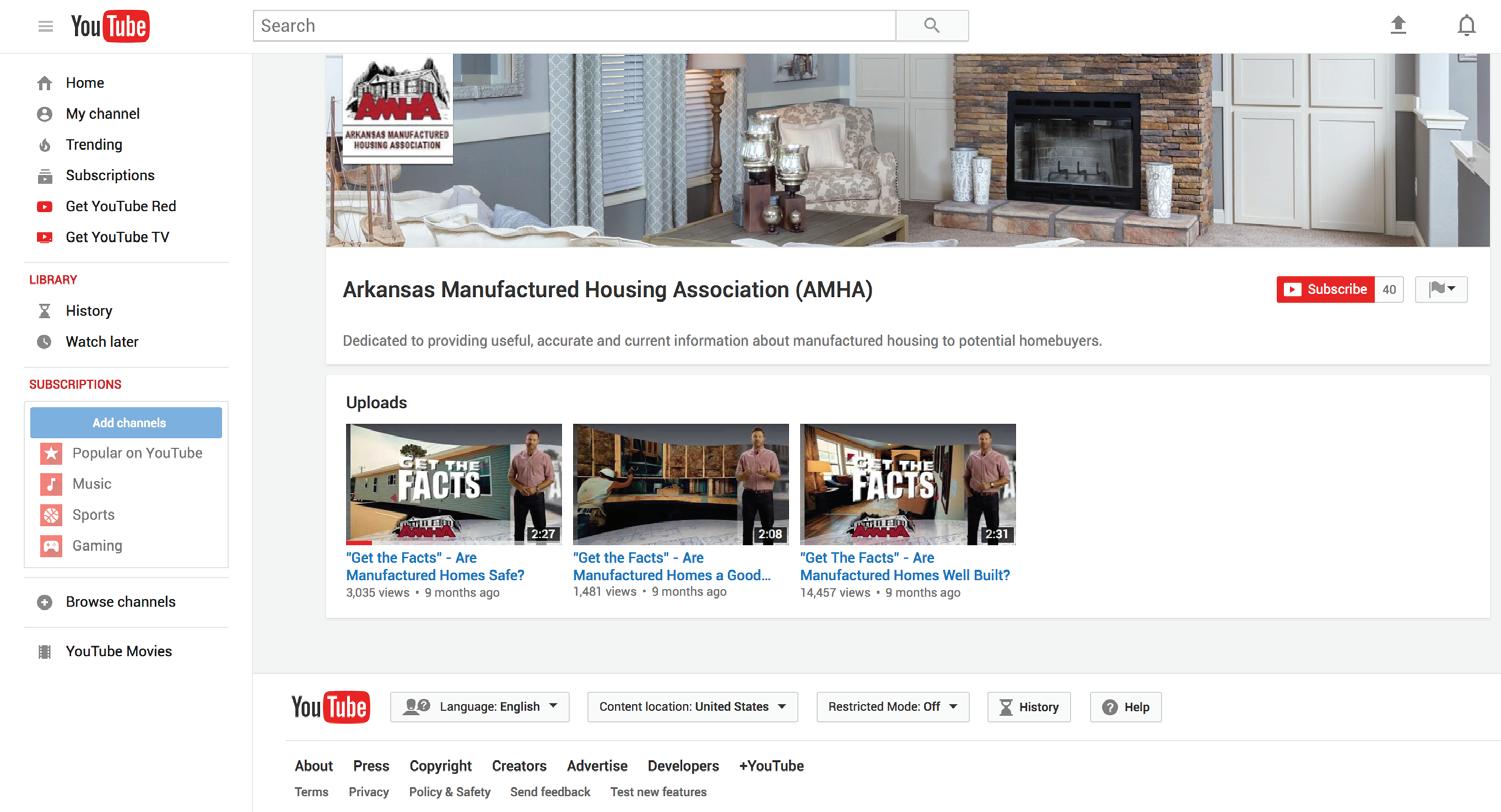
JUNE 2017 ISSUE • 281.460.8384 • ManufacturedHousingReview.com - 23 -
Coming Soon To A Mobile Home Park Near You Benjamin Ivry
The Peculiar Story Of Mhaction.org
Who needs to pay 14 dollars or more to see Logan or The Fate of the Furious in a multiplex when there are free thrills and chills to be had by trying to stomach the crazy hypocrisy of American non-profits? According to an article in the Wall Street Journal the other day, non-profits are paying over 2,700 of their staff more than $1 million per year in annual compensation https://www.wsj.com/articles/ charity-officials-are-increasingly-receiving-million-dollarpaydays-1488754532 They are minting millionaires faster than the NFL. While that’s embarrassing enough for many charities that serve wealthy patrons, it’s a scandal when they are enriching themselves off the shoulders of people with meager incomes, and such is the potential plight of MHAction.org.
Here are the facts as we know them: MHAction.org is a nonprofit based in Washington, D.C., part of the larger Center for Community Change. Although its website provides no details – not even a street address—a little cyber-sleuthing will uncover their Form 990 report (that all 501 C-3s must file and can be found at www.GuideStar.com). It shows that the Executive Director Deepak Bhargava receives about $257,263 per year. At $24 per annum in dues, that means that the first 10,719 mobile home park members just about fund his compensation. And the next four employees make a total of $1,004,904 – so it takes around another 41,871 mobile home park residents to send in their $24 to cover those folks. So if you are among the first 52,290 members of MHAction. org, you’ve done a wonderful thing; you just covered the salary of five people who are living it up while you’re sitting in your trailer. But you better tell all your friends and neighbors to send in their dues quickly, as the Center for Community Change’s total payroll is more than $9 million. It’s going to take 375,000 members to cover that tab! I wonder if those who join MHAction.org are aware of how their money is being used? Doubtful.
But what really bothers me about these comfortable, lucky nonprofit activists is that they can’t just say “OK, we’re really just a bunch of opportunists milking the system for all it’s worth.” Instead they apparently try to hide who they really are. On the MH Action.org website their address is listed as “P.O. Box 27, New Paltz, NY 12561” while the Center for Community Change’s actual office is in Washington, D.C. So why the lack of transparency? It’s probably hard to collect the mail in New
Paltz when your office is in Washington, D.C. but I imagine it’s worth the extra effort to conceal that you’re dining on pheasant under glass while getting checks for $24 per year from folks subsisting on Value Meals. That’s right, the group is apparently built on donations from those who can least afford them. Here’s the actual (and embarrassing) dues request from their website:
“There are three levels of giving, and MHAction goodies for each level:
• $2/month provides access to our quarterly newsletter and a MHAction comic book, illustrating manufactured homeowners’ stories.
• $5/month and we’ll throw in a MHAction bumper sticker.
• $10+/month and you’ll also receive a MHAction tee-shirt (make sure to include your size).
For the extra-industrious, this great deal is also offered:
• “Core Team Leaders make a financial commitment of $24/ year to MHAction and are expected to recruit a minimum of 5 yearly supporters of $24/year”.
What a terrific opportunity to not only waste your own money, but even rip off friends and neighbors! What fun!
But of course, don’t forget their great accomplishments to date… actually, I can’t even find a single one mentioned on their website. But they do share stories such as this one from Dale Muzzy of Florida who declares about an ELS mobile home park:
“At first, living there was worry-free. But since, our experience has soured. ELS used to cover water, sewer and trash pickup as a part of our monthly rent. But ELS took away those services, forced the costs on the homeowners and did nothing to reduce our rent. Our community center is falling into disrepair and has just been inspected due to a large number of safety violations. The longer we live here, the more it’s clear to us that ELS communities are operated by predatory equity schemes designed to make Zell very rich.”
JUNE 2017 ISSUE • 281.460.8384 • ManufacturedHousingReview.com - 24 -
Coming Soon To A Mobile Home Park Near You cont.
Let me get this right; Sam Zell had the audacity to make residents pay for their own utilities? What an outrageous request! One would think that the entitlement era is over and people actually have to pay their own bills these days. I’m not sure, but I suppose that any resentment of Zell’s wealth might be diminished if it was realized how much the folks are making where those $2 dues are going.
Before American mobile home park residents send in their $24, they might want to ask first: “Who are these folks and what is their compensation?” Until charities such as MHAction.
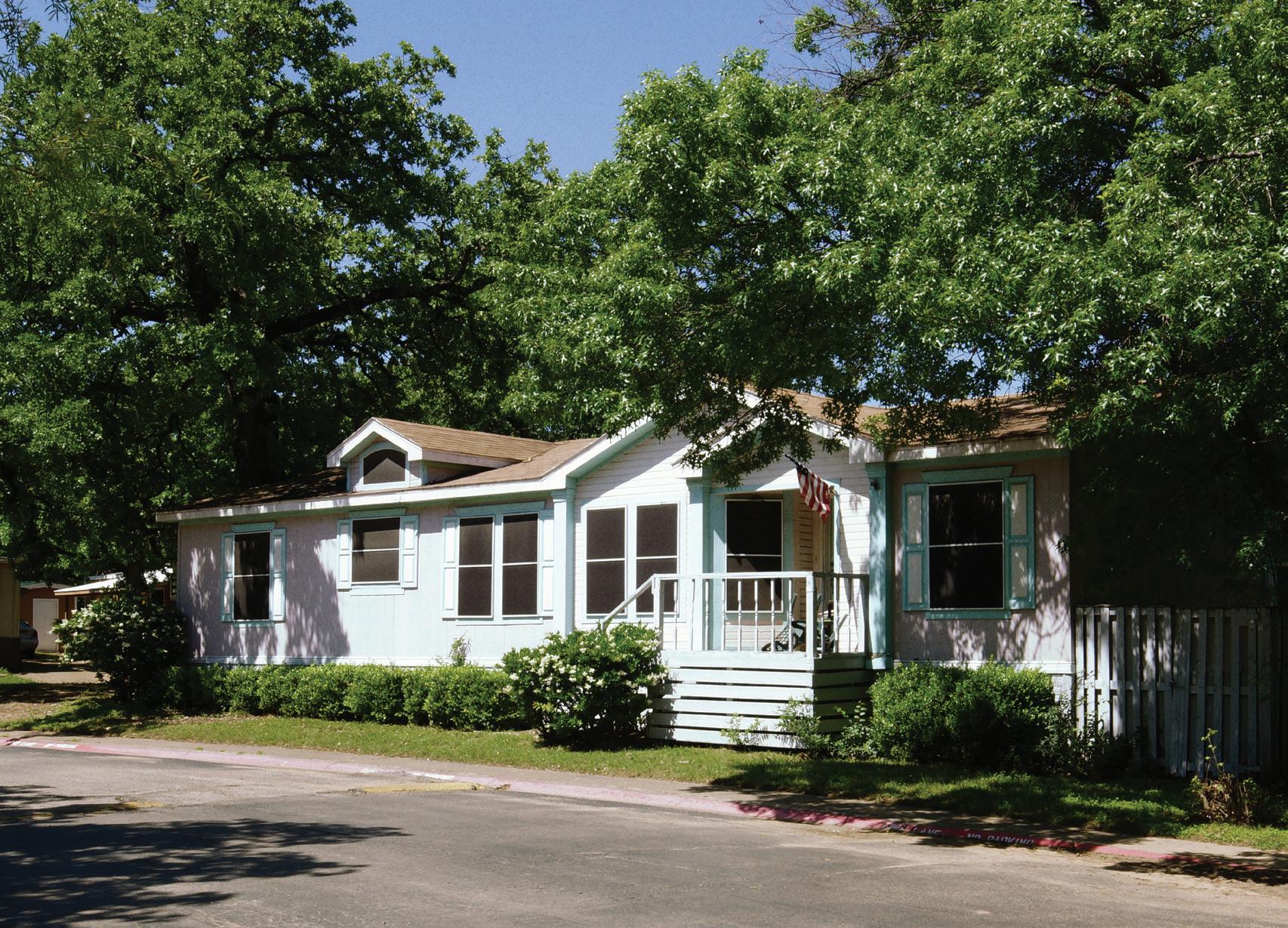
org are honest and open about who they are and where their money goes -- and how much their leaders are paid -- it would appear this is another case of the pot calling the kettle black. At least Sam Zell provides a nice, clean, safe place to live. What does MHAction.org provide other than an undiluted ripoff for their disadvantaged backers?
Benjamin Ivry has written for The Economist, The Wall Street Journal, BloombergNews, and other outlets.
JUNE 2017 ISSUE • 281.460.8384 • ManufacturedHousingReview.com - 25 -
MHR MANUFACTURED HOUSING REVIEW We are an electronically delivered monthly magazine focused on the Manufactured Housing Industry. From Manufactured Home Community Managers, to Retailers, to Manufacturers, and all those that supply and service them, we supply news and educational articles that help them run their businesses. 281.460.8384 ManufacturedHousingReview.com Communications regarding any alleged offending, inappropriate, inaccurate or infringing content should be directed immediately to kkelley@manufacturedhousingreview.com along with the communicator’s contact information. Have something to contribute or advertise? Email us at staff@manufacturedhousingreview.com






























